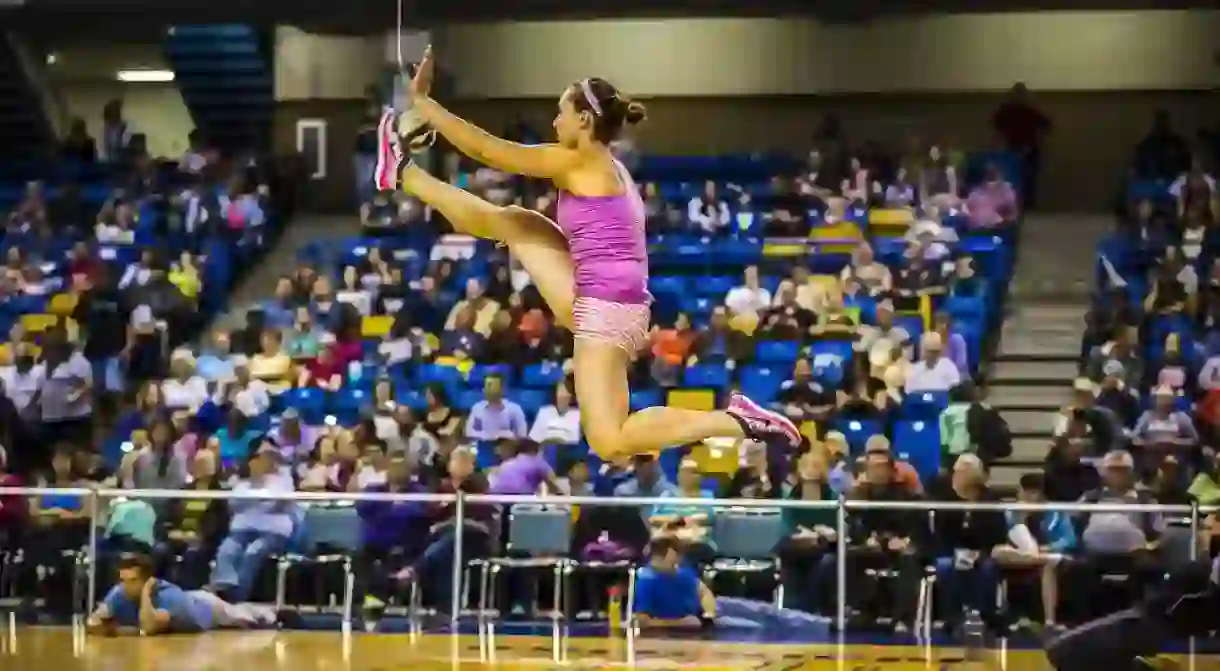How the World Eskimo-Indian Olympics Celebrate Native Culture

The World Eskimo-Indian Olympics (WEIO) are held annually in Fairbanks, Alaska. The four-day event celebrates and promotes the culture of native peoples.
Erica Meckel was headed down a bad path.
Regardless of the consequences, Meckel would go out every Friday and Saturday night, sometimes even drinking during the week. Her parents were at their wits’ end, even threatening to kick their 18-year-old daughter out of the house because she wouldn’t stop partying.
“It was hurting my family and friends, but I was too selfish to see that,” Meckel says.
That’s when Meckel found a new road. At the behest of a friend, she started competing in the World Eskimo-Indian Olympics in her home town of Fairbanks, Alaska.

Originally known as the World Eskimo Olympics when they began in 1961, WEIO, which takes place over four days each July, “promotes the cultural expertise and traditions of Alaska, Greenland, Siberian and Canadian Inuit, and Native Americans” through athletic competitions, pageants and dancing. Competitive events like knuckle hop, seal skinning and greased-pole walk display the preparedness native peoples need for survival.
“When I started competing in WEIO and went to my first competition, my eyes were opened to the beauty of my culture,” Meckel says. “I felt like there were young athletes who looked up to me. I couldn’t tell them to be healthy and strong Alaskan Natives if I wasn’t living that lifestyle myself.”
After participating in the 2006 WEIO, Meckel redirected her energy from partying to training. Instead of going out on weekends, she’d be in bed early so she could be up at sunrise to go to the gym. This refocus also guided her to her current profession as a pretrial enforcement division officer, supervising and monitoring defendants who are waiting for their case to be resolved.
WEIO has been a multi-layered experience for Meckel, now 30. Not only has it helped her personal journey; it has fueled her competitive drive and strengthened her sense of culture and community. She refers to coach and mentor Nicole Johnston as her “WEIO mom.” Amber Vaska, Meckel’s stiffest competitor since she started participating in the games, is like a sister to her.

“The sense of camaraderie is almost unreal when you go to WEIO,” Meckel says. “I’ve never seen another competition where opponents push each other to do better. Although you want to win because of the competitive nature, you want each person to reach their potential.
“The spirit of it comes from hunters needing to succeed hundreds of years ago and helping each other with survival; if one person failed and wasn’t able to provide, the entire village failed.”
That’s why the WEIO athletic competitions aren’t conventional sports or events. The importance is on tradition and showcasing a skill set necessary for survival. The ear weight event – where participants try to walk the farthest with 16-pound (7kg) weights hanging off string tied around their ears – is a test of endurance derived from being able to survive frostbite pain. In Indian stick pull, competitors’ grip is tested as they try to pry a greased stick from one another’s hands, mimicking grabbing a fish by the tail.

Meckel used to participate in all of the events, including knuckle hop, two-foot high kick, Alaskan high kick, scissor broad jump and kneel jump, but has lessened her activities as she’s gotten older. She now focuses on one-foot high kick, kneel jump and scissor broad jump, along with a few events just for fun.
Approximately 200 competitors test their mettle in the athletic events, some in two or three, while others in 15 or 20. Participants have to be at least 12 years old to compete.
“People who competed in the first WEIO are now coming with their kids and grandkids who compete,” says Sanford ‘Sam’ Strange, WEIO board vice-chair, head official and competitor. “My son is now old enough to compete. He medaled in the blanket toss in 2017. My wife competes and I compete. It’s a big family event.”
WEIO has had to cope with the balance of promoting and preserving native cultures while also evolving with the times of the 21st century and influence of popular culture. Native cultures had a gender discrepancy of activities and roles based on the environment, so the games had a separation as well. In consultation with the respected elders, WEIO permits limited participation by women in events traditionally reserved for men, so long as the female athletes “request permission” from the men. As the WEIO website states: “This is not meant to discount or insult our women, but rather to show culturally appropriate respect to our men.”
“When WEIO was founded, it was to help preserve and share the vast diversity of culture,” Strange says. “It’s huge to share it with youth today. Our society is always evolving, and you hope to preserve that culture no matter where you are in the world [or] what your native culture may be.”













